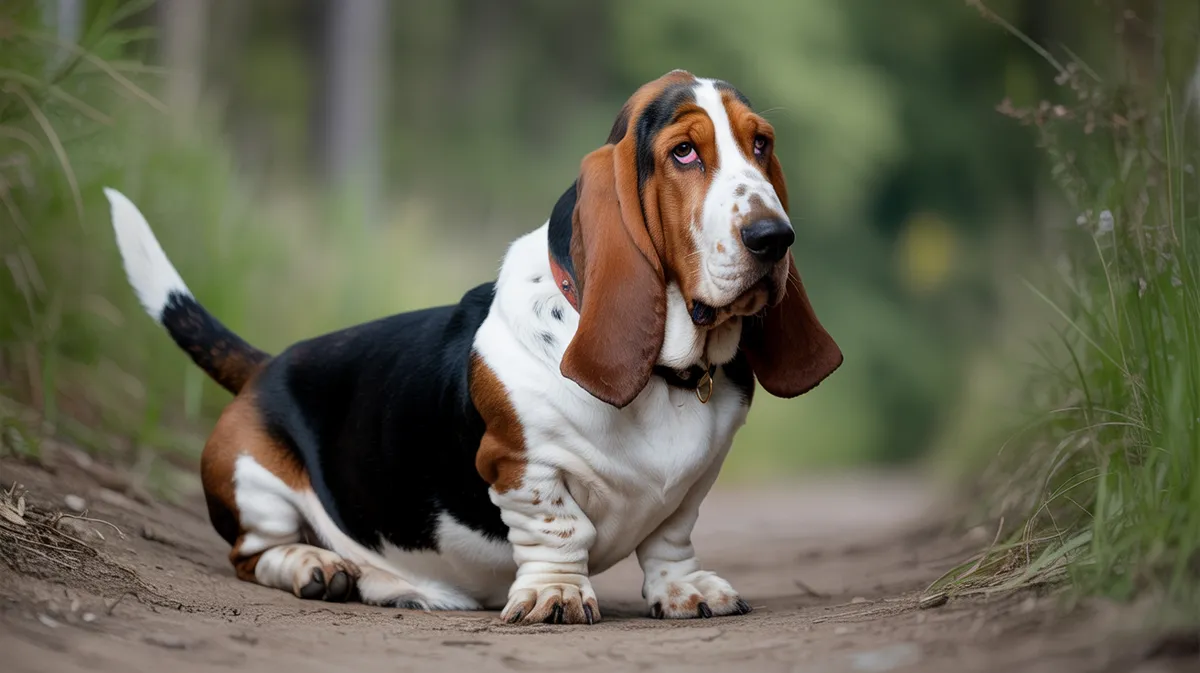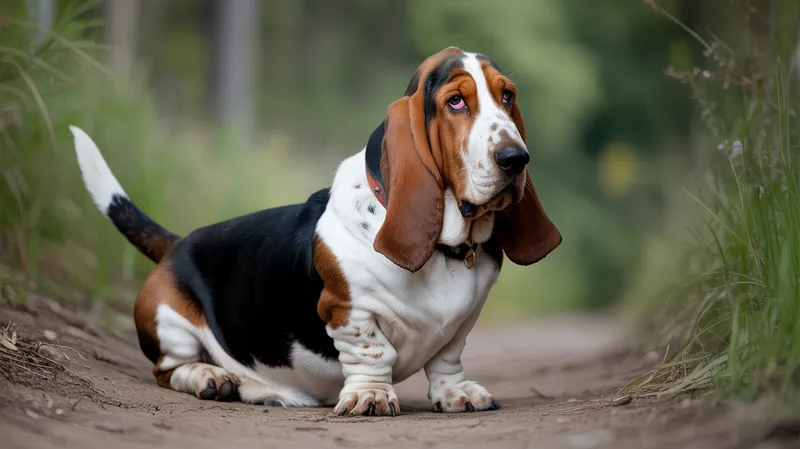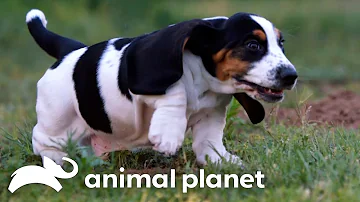
Basset Hound
Canis lupus familiaris

Meet the Basset Hound
The Basset Hound is a distinctive dog breed known for its long ears, droopy eyes, and short legs. Originally bred in France for hunting small game such as rabbits due to their excellent sense of smell, Basset Hounds are renowned for their persistence and tracking abilities. They have a gentle, affectionate temperament, making them excellent family pets, but their stubborn streak can pose a challenge during training. Despite their low stature, they are sturdy and surprisingly agile, with a deep bark and a strong sense of loyalty.
Classification
Mammal
Habitat
Domestic; originally developed for rural and forested regions
Diet
Omnivore
Lifespan
10-12 years
Conservation
Least Concern
Weight
20-29 kg (44-64 lbs)
📖Fascinating Facts
Super Sniffer
Basset Hounds have around 220 million scent receptors, giving them an extraordinary sense of smell for tracking.
Long Ears’ Purpose
Their famously long ears are not just for show—they help trap scent particles near the nose while tracking.
Stubborn but Loyal
Basset Hounds are known for their stubbornness, but they are also extremely devoted and gentle with families and children.
📋Detailed Description
The Basset Hound is a medium-sized scent hound, instantly recognizable by its elongated body, extremely short legs (a result of chondrodysplasia), and long, pendulous ears that can reach beyond the tip of its nose. Its loose, elastic skin, particularly around the face and neck, forms characteristic wrinkles and helps trap scent particles close to the nose, enhancing olfactory tracking. The breed typically weighs between 20–34 kg (45–75 lbs) and stands 28–38 cm (11–15 in) at the shoulder, with males generally larger than females. The Basset Hound's coat is short, dense, and weather-resistant, coming in a variety of hound colors, most commonly tricolor (black, white, and tan) or bicolor (lemon and white). Their large, soulful eyes and drooping lower eyelids give them a distinctive, mournful expression. Despite their low stature, Basset Hounds are muscular and surprisingly agile, capable of sustained activity during tracking. Behaviorally, they are known for their gentle, affectionate nature, but also for a marked stubbornness and independence. Socially, they are pack-oriented, thriving in groups and forming strong bonds with both humans and other dogs. Reproductively, they have moderate litter sizes (6–8 puppies), and their maternal instincts are well-developed, with attentive care given to offspring. Unique among scent hounds, their sense of smell is second only to the Bloodhound, with over 220 million scent receptors, making them exceptional trackers.
💡 Did you know?
Despite their sad-looking expression and slow gait, Basset Hounds are very determined hunters that can track a scent for miles without giving up.
🔬Research & Sources
Wikipedia Summary
The Basset Hound is a short-legged breed of scent hound. The Basset Hound was developed in Great Britain from several now-extinct strains of French basset breeds. It was bred primarily for hunting rabbit and hare on foot, moving slowly enough that horses were not required. Their sense of smell and ability to ground-scent is second only to the Bloodhound.
Last Modified: 5/26/2025
🎭Behavior & Social Structure
Basset Hounds are highly scent-driven and will often follow their noses with single-minded determination, sometimes to the exclusion of commands or environmental cues. Historically used for hunting small game such as rabbits and hares, they employ a slow, methodical tracking style, relying on ground-scenting rather than air-scenting. In domestic settings, this translates to a tendency to investigate scents persistently, sometimes leading to wandering if not supervised. They are generally calm and laid-back indoors, enjoying long periods of rest interspersed with bursts of activity, especially when outdoors or engaged in scent games. Socially, Basset Hounds are gregarious and do well in multi-dog households, displaying minimal aggression and a preference for companionship. They are vocal, using a deep bay or howl to communicate, particularly when excited or left alone. Their stubbornness can make training a challenge, requiring patience, positive reinforcement, and consistency.
👶Reproduction & Life Cycle
Basset Hounds reach sexual maturity between 6–12 months, though responsible breeding is typically delayed until at least 18–24 months to ensure full physical development. The breed does not have a strict breeding season, as with most domestic dogs, but estrus cycles occur approximately twice a year. Gestation lasts about 63 days. Litter sizes average 6–8 puppies, though larger litters are not uncommon. Birthing can be complicated due to the breed’s body structure and large heads of the puppies, sometimes necessitating veterinary assistance or cesarean sections. Maternal care is strong, with mothers providing attentive nursing and grooming. Puppies are born blind and deaf, opening their eyes at around 10–14 days. Early socialization is important to foster stable temperaments.
🛡️Adaptations & Survival
The Basset Hound’s most notable adaptation is its exceptional olfactory system, with an enlarged nasal cavity and a high density of scent receptors. The long, low-set ears help stir up scent particles from the ground and direct them toward the nose, while the loose skin around the head and neck creates folds that trap scent. Their short, sturdy legs keep them close to the ground, optimizing ground-scent tracking and allowing them to move slowly and deliberately—an advantage for hunters on foot. The deep chest provides ample lung capacity for endurance during long tracking sessions. Behaviorally, their persistence and independence are adaptations for following scent trails over extended periods without distraction.
📚Research Sources
🎨Cultural Significance
Basset Hounds have a prominent place in popular culture, often depicted as symbols of loyalty, melancholy, and determination. Their distinctive appearance has made them favorites in advertising, cartoons (such as Droopy Dog), and film. In France and Britain, they were historically valued as hunting companions for nobility and rural hunters alike. Today, they are cherished as family pets and occasionally participate in scent work, tracking trials, and canine sports. The breed’s image is frequently used to evoke humor and pathos, and Basset Hound clubs and societies are active worldwide, promoting breed welfare and responsible ownership.
🔬Recent Research & Discoveries
Recent genetic studies have confirmed the Basset Hound’s close relationship to other French scent hounds and have identified specific mutations responsible for their dwarfism (chondrodysplasia). Ongoing research focuses on improving breed health, particularly regarding musculoskeletal and ocular disorders. Studies of canine olfaction continue to highlight the Basset Hound’s value as a model for scent detection, with applications in search-and-rescue and medical detection. Behavioral research has examined their problem-solving abilities and the impact of selective breeding on temperament and trainability.
🎥Wildlife Videos

Dogs 101- Basset Hound
Watch More At: http://animal.discovery.com/videos/dogs-101-season-one/?smid=YTAPC-YTD-PLP The Basset Hound holds the ...
Animal Planet

earth's deadliest animal: basset hound
Thanks for watching! If you want to see more of Dean check out some of our favourite videos of him.
Dean the Basset

Basset Hound Puppies Play Hide and Seek With a Hamster | Too Cute! | Animal Planet
Witness these little fur balls as they embark on a fascinating journey of smelling and discovering their surroundings. With their ...
Animal Planet

Secret Life of Dogs: Basset hound shakes off water in ultra slow motion
Amazing footage from "Secret Life of Dogs" narrated by Martin Clunes. Basset hound shakes off water. Filmed using a Phantom ...
Alex Boyle

Basset Hound Documentary
Bryan Decker

Wildlife Stories: Love is in the Wild | SPECIAL | Free Documentary Nature
Wildlife Stories: Love is in the Wild | Special | Free Documentary Nature Watch 'Wildlife Stories: Talking to Survive' here: ...
Free Documentary - Nature
🌍Habitat Information
The Basset Hound typically inhabits Domestic; originally developed for rural and forested regions environments. Basset Hounds have adapted to their environments with specialized features and behaviors.
Primary Habitat:
Domestic; originally developed for rural and forested regions
More detailed habitat information will be available soon.
🛡️Conservation Status
The Basset Hound is currently classified as Least Concern. Conservation efforts are crucial for preserving this species for future generations.
Common Threats:
- 🏠Habitat loss and fragmentation
- 🌡️Climate change impacts
- 🎯Hunting and poaching
- 🏭Human-wildlife conflict
⚠️Threats & Conservation Challenges
As a domestic breed, Basset Hounds are not threatened in the wild and are classified as 'Least Concern.' However, they face several health challenges due to selective breeding for their unique morphology. Common issues include intervertebral disc disease, hip and elbow dysplasia, ear infections (due to long, pendulous ears), obesity, and entropion or ectropion of the eyelids. Their stubbornness can also lead to behavioral problems if not managed with proper training and socialization. Overbreeding and puppy mills have contributed to the propagation of hereditary diseases. Responsible breeding practices and regular veterinary care are essential to maintaining breed health.
🔬Scientific Classification
Scientific Name
Canis lupus familiaris
Classification Hierarchy
🔍 About Taxonomic Classification
Taxonomic classification is a hierarchical system used by scientists to classify and organize living organisms based on shared characteristics and evolutionary relationships.
The system moves from broad categories (Kingdom) to increasingly specific ones, with each animal's scientific name typically consisting of its Genus and species.
📝Community Notes
Share your observations and insights about the Basset Hound with our community of wildlife enthusiasts.
Join Our Community
Sign in to share your observations and connect with fellow wildlife enthusiasts.
Sign In to ContributeNo community notes yet
Be the first to share your observations about the Basset Hound!
Explore Basset Hound
Select a tab above to learn more about this amazing animal.
📸Photo Gallery
No photos available for this animal yet.
🌟Discover More Wildlife
Continue your journey of discovery with more fascinating animals from our database
